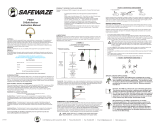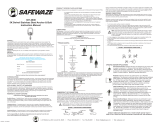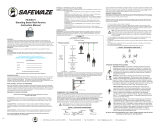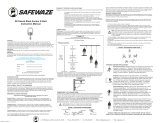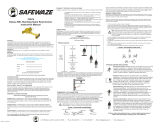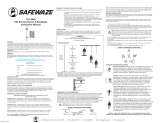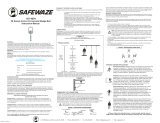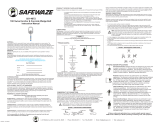Page is loading ...

Address: 225 Wilshire Ave SW, Concord, NC 28025 Phone: 800-230-0319 Email: [email protected] Website: safewaze.com Fax: 704-262-9051
I I
022-4092 (Screws in Wood)
ALLOWED ANCHOR APPLICATIONS
The TileLink Anchor is not for use in lifting, rappelling, or Horizontal Lifeline applications.
LIMITATIONS
Always select a lanyard and anchor point location that limits free fall and swing fall as much as
possible. A free fall of more than 6 ft. could cause excessive arre forces that could result in
serious injury or death.
Anchorages for the attachment of a Personal Fall Arrest System shall support a minimum 3,600
lbs. (16 kN) or be designed with a safety factor of two to one by a Qualied Person.
Fall Clearance: There must be sucient clearance below the anchorage connector to arrest a
fall before the user strikes the ground or an obstruction. When calculating fall clearance, account
for a MINIMUM 2’ safety factor, deceleration distance, user height, length of lanyard/SRL, and all
other applicable factors (Figure 1).
FIGURE 1: FALL CLEARANCE DIAGRAM
*This diagram is an example of fall clearance calculation ONLY.
Swing Falls: Prior to installation or use, make considerations for eliminating or minimizing all
swing fall hazards. Swing falls occur when the anchor is not directly above the location where
a fall occurs. Always work as close to, or in line with, the anchor point as possible. Swing falls
signicantly increase the likelihood of serious injury or death in the event of a fall (Figure 2).
FIGURE 2: SWING FALL
022-4092 and 022-4094
TileLink Roof Anchor Manual
INTRODUCTION
Thank you for purchasing a Safewaze TileLink Roof Anchor. This manual must be read and
understood in its entirety and used as part of an employee training program as required by
OSHA or any applicable state agency. This manual and any other instructional material must be
available to the user of the equipment. Every user must be trained in the inspection, installation,
operation, and proper usage of the anchor.
LOAD INDICATOR
LOAD INDICA
TOR
A
FALL-ARREST
ANSI Z359.14, ANSI A10.32
OSHA 1910.66, OSHA 1926.502
S
W
I
N
G
F
A
L
L
Required
Distance
from
Anchorage
(17.5’ Total)
Lanyard Length
(6’ Total)
Deceleration
Distance (3.5’ Total)
Height of Harness Dorsal
D-ring from
Worker’s Feet
(6’ Total)
Safety Factor
(2’ Total)
For all applications, worker weight capacity range
(including all clothing, tools, and equipment) is
130-310 lbs. (59-141 kg).
COMPATIBILITY OF COMPONENTS/CONNECTORS
• Safewaze equipment is designed for, and tested with, associated Safewaze components
or systems. If substitutions or replacements are made, ensure all components meet the
applicable ANSI requirements. Read and follow manufacturer’s instructions for all components
and subsystems in your PFAS. Not following this guidance may jeopardize compatibility of
equipment and possibly aect the safety and reliability of the system.
• Connectors are compatible with connecting elements when they have been designed to work
together in such a way that their sizes and shapes do not cause their gate mechanisms to
inadvertently open regardless of how they become oriented.
• Connectors (hooks, carabiners, and D-rings) must be capable of supporting at least 5,000 lbs.
(22 kN).
• Connectors must be compatible with the anchorage or other system components.
• Do not use equipment that is not compatible. Non-compatible connectors may unintentionally
disengage (Figure 3).
• Connectors must be compatible in size, shape, and strength.
• Self-locking snap hooks and carabiners are required by OSHA guidelines.
• Some specialty connectors have additional requirements. Contact Safewaze if you have any
questions about compatibility.
FIGURE 3: UNINTENTIONAL DISENGAGEMENT
Using a connector that is undersized or irregular in shape (1) to connect a snap hook or
carabiner could allow the connector to force open the gate of the snap hook or carabiner. When
force is applied, the gate of the hook or carabiner presses against the non-compliant part (2)
and forces open the gate (3). This allows the snap hook or carabiner to disengage (4) from the
connection point.
2. Gate Presses
Against
Non-Compliant Part
1. Non-Compliant Part 3. Gate Opens
4. Parts
Disengage
ANCHORAGE INSTALLATION LOCATION
A Qualied Person or Engineer must conduct an analysis of the workplace and anticipate where
workers will be performing their duties. An anchorage location selected for a Personal Fall Arrest
System (PFAS) must have a strength capable of sustaining a static load applied in the direction
permitted by the PFAS of at least:
• Two times the maximum arrest force permitted when certication exists, or
• 3,600 lbs. (16 kN) or be designed with a safety factor of two to one in the absence of
certication.
APPLICABLE SAFETY STANDARDS
When used according to instructions, Safewaze Anchors meet OSHA 1926.502, 1910.140, and
1910.66 regulations. Applicable standards and regulations depend on the type of work being
done and may include state-specic regulations. Refer to local, state, and federal requirements
for additional information on the governing of occupational safety regarding Personal Fall Arrest
Systems (PFAS).
WARNING:
The manufacturer’s instructions must be provided to users of this equipment. The user must
follow the manufacturer’s instructions for each component of the system. The user must read
and understand these instructions before using this equipment. Manufacturer’s instructions
must be followed for proper use and maintenance of this equipment. The user must understand
how to safely and eectively use the 022-4092/022-4094 roof anchor and all equipment used in
conjunction with 022-4092/022-4094. Alterations to this product, misuse of this product, or failure
to follow instructions may result in serious injury or death. Avoid moving machinery, sharp and/or
abrasive edges, and any other hazard that could damage or degrade the component.
Do not throw away instructions!
Read and understand instructions before using equipment!
IMPORTANT:
• Please refer to this manual for essential instruction on the use, care, or suitability of this
equipment for your application. Contact Safewaze for any additional questions.
• Only Safewaze, or entities authorized in writing by Safewaze, may make repairs to
Safewaze fall protection equipment.
• Record all important product information below prior to use. Documentation of all
Competent Person annual inspections is required in the Inspection Log.
MAKING CONNECTIONS
Snap hooks and carabiners used with this equipment must be double locking and/or twist lock.
Ensure all connections are compatible in size, shape, and strength. Do not use equipment that
is not compatible.
Ensure all connectors are fully closed and locked.
Large throat snap hooks must not be connected to standard size D-rings or similar objects which
will result in a load on the gate if the hook or D-ring twists or rotates, unless the snap hook
complies with ANSI Z359.1-2007 or ANSI Z359.12 and is equipped with a 3,600 lb. (16 kN) gate.
V2. 2023 Copyright Safewaze: 220-00096
SPECIFICATIONS
• Capacity: The TileLink Roof Anchor is designed to provide a fall protection anchorage for a
single user with a maximum weight of 130 to 310 lbs. (59-141 kg) including any tools, clothing,
accessories, etc.
• 022-4092’s fasteners are screws and 022-4094’s fasteners are rivets.
• Temporary and permanent installation options.
• Minimum Breaking Strength (MBS) is 3,600 lbs. (16 kN)
USER INFORMATION
Date of First Use:
Serial Number:
Trainer:
User:
WORKER CLASSIFICATIONS
Read and understand the denitions of those who work in proximity of, or may be exposed
to, fall hazards:
Qualied Engineer: “Qualied Engineer” means a person with a Bachelor of Science in
Engineering degree from an accredited college or university. They are able to assume personal
responsibility for the development and application of engineering science and knowledge in the
design, construction, use, and maintenance of their projects.
Qualied Person: “Qualied Person” means one who, by possession of a recognized degree,
certicate, or professional standing, or who by extensive knowledge, training, and experience, has
successfully demonstrated their ability to solve or resolve problems relating to the subject matter,
the work, or the project.
Competent Person: “Competent Person” means one who is capable of identifying existing and
predictable hazards in the surroundings or working conditions which are unsanitary, hazardous,
or dangerous to employees, and who has authorization to take prompt corrective measures to
eliminate them.
Authorized Person: “Authorized Person” means a person approved or assigned by the employer
to perform a specic type of duty or duties, or to be at a specic location or locations, at the jobsite.
It is the responsibility of a Qualied Person or Engineer to supervise the jobsite and ensure
safety regulations are complied with.
Restraint: Safewaze Anchors are authorized for use in Restraint applications. The
structure to which the anchor is attached must withstand loads applied in the directions
permitted by the system of at least 1,000 lbs. NO free fall is permitted. Restraint
systems may only be used on surfaces with slopes up to 4/12 (vertical/horizontal). For
Restraint applications, the allowable attachment points to the harness are Dorsal,
Front/Sternal, Side, and Shoulder D-rings.
Work Positioning: Safewaze Anchors are authorized for use in Work Positioning
applications. Work Positioning allows a worker to be supported during suspension while
freeing both hands to conduct work operations. The structure to which the Anchor is
attached must withstand loads applied in the directions permitted by the system of at
least 3,000 lbs. Maximum allowable free fall is 2’ ft. For positioning applications, the
allowable attachment points to the harness are the Side D-rings.
Rescue/Conned Space: Safewaze Anchors are authorized for use in Rescue/
Conned Space applications. Rescue systems are utilized to safely recover a worker
from a conned location or after exposure to a fall. Composition of rescue systems
can vary based upon the type of rescue involved. The structure to which the Anchor
is attached must withstand loads applied in the directions permitted by the system
of at least 3,100 lbs. NO free fall is permitted. For rescue applications, the allowable
attachment points to the harness are Dorsal, Front/Sternal, and Shoulder D-rings.
Personal Fall Arrest: Safewaze Anchors are designed as an anchor point to support a
maximum of 1 PFAS when utilized for fall protection applications. The structure to which
the anchor is attached must withstand loads applied in the directions permitted by the
system of at least 5,000 lbs. (22 kN) or be designed with a safety factor of two to one.
Maximum allowable freefall is based on the connector used.
022-4094 (Rivets in Metal)

Address: 225 Wilshire Ave SW, Concord, NC 28025 Phone: 800-230-0319 Email: [email protected] Website: safewaze.com Fax: 704-262-9051 II
FIGURE 5: ANCHOR COMPONENTS
Anchor Components Materials
1 Anchor Plate Stainless Steel
2Screws (022-4092) Galvanized Steel
3Rivets (022-4094) Aluminum
1
2
3
2
1
LABELS
INSPECTION LOG
WARNINGS
• Users should consult with their doctor to verify ability to safely absorb the forces of a fall
arrest event.
• Fitness level, age, and other health conditions can greatly aect an individuals ability to
withstand fall arrest forces.
• Women who are pregnant and individuals considered minors must not use any Safewaze
equipment.
• Anchors that are exposed to fall arrest forces must be IMMEDIATELY removed from service
and destroyed.
• A preplanned rescue procedure in the event of a fall is required. The rescue plan must be
specic to the project.
• The rescue plan must allow for employees to rescue themselves or be promptly rescued by
alternative means.
• A Competent Person must conduct an analysis of the workplace and anticipate where workers
will be conducting their duties, the route they will take to reach their work, and the existing and
potential fall hazards they may be exposed to.
• The Competent Person must choose the fall protection equipment to be utilized.
• Equipment designated for fall protection must never be used to lift, hang, support, or hoist
tools or equipment unless specically certied for such use.
MAINTENANCE
• The anchor can be cleaned with water and mild soap if necessary. The user should remove
all dirt, possible corrosives, and contaminants from the anchor prior to, and after, each use.
Never use any type of corrosive substance to clean the anchor.
• Excess water should be blown out with compressed air. Hardware can be wiped o with a
clean, dry cloth.
• Do not store anchor if wet or damp. Allow anchor to fully dry before being stored.
• When not in use, store the anchor in a cool, dry area where it will not be exposed to extreme
light, extreme heat, excessive moisture, or possibly corrosive chemicals or materials.
Inspection
Date:
Inspector: Pass/Fail: Comments/
Corrective Action:
INSPECTION LOG
ANNUAL FORM
PRIOR TO INSTALLATION
• The user should conrm no parts are missing, such as the screws or rivets.
• The Labeling should be inspected to ensure it is present and fully legible.
• If the inspection indicates any defects, the anchor must be removed from service.
• The TileLink Anchor has two energy absorbing regions and two stabilizing joins. If these
energy absorbing regions are expanded or deformed, or if either of the joins are broken, the
anchor has arrested a fall and should be immediately removed from service.
• The eyelet should be straight and in line with the anchor. If the eyelet is distorted or de-
formed, the anchor has arrested a fall and should be immediately removed from service.
• Remove the roof tiles in the desired anchorage location to expose the truss beneath the tiles.
• A Qualied Person or Engineer must ensure the truss is strong enough to support the anchor
point.
• Inspect the truss for splits, cracks, knots, and insect damage prior to installing the anchor.
INSPECTION
• Safewaze Anchors should be inspected prior to each use by the user and at least annually by
a Competent Person other than the user.
• Competent Person inspections must be recorded in the Inspection Log included in this
manual and on the inspection grid label on the anchor.
• Severity of conditions during use of the anchor may necessitate increased frequency of
documented inspections.
• Prior to each use, inspect the anchor for deciencies or damage including, but not limited to,
sharp edges, rough edges, deformations, corrosion, pits, burrs, chemical exposure, extreme
heat exposure, and damaged, missing, or illegible labels.
• If any deciencies or defects are found, the anchor must IMMEDIATELY be removed from
service.
INSTALLATION
• The TileLink Anchor is best suited for use on roof pitches of 7/12. For roof pitches greater
than 7/12, the anchor should be used in conjunction with other access methods to ensure
there is no live loading of the anchor. Place the anchor on the truss. Adjust the anchor
plate to suit the prole of the roof.
• Choose one of the 3 or 5 rows of holes that best centers the anchor on the truss.
• Install the anchor using ve screws or rivets in the same row.
• The pilot holes must be drilled into the truss the full length of each screw or rivet to avoid
splitting the timber of the truss.
• Replace the roof tiles and add silicone in between the tiles.
xxxxxx
022-4092
TileLink (Screws)
022-4094
TileLink (Rivets)
Wood Truss
Screws (5x) Rivets (5x)
Steel Truss
Working Radius
15º
15º
Working Radius
15º
15º
xxxxxx
022-4092
TileLink (Screws)
022-4094
TileLink (Rivets)
Wood Truss
Screws (5x) Rivets (5x)
Steel Truss
Working Radius
15º
15º
Working Radius
15º
15º
MAKING CONNECTIONS CONTINUED
Safewaze connectors (hooks, carabiners, and D-rings) are designed to be used only as specied
in each product’s manual. See Figure 4 for examples of inappropriate connections. Do not
connect snap hooks and carabiners:
• To a D-ring to which another connector is attached.
• In a manner that would result in a load on the gate (with the exception of tie-back hooks).
• In a false engagement, where features that protrude from the snap hook or carabiner catch
on the anchor, and without visual conrmation seems to be fully engaged to the anchor point.
• To each other.
• By wrapping the web lifeline around an anchor and securing to lifeline, except as allowed for
tie-back models.
• To any object which is shaped or sized in a way that the snap hook or carabiner will not close
and lock, or that roll-out could occur.
• In a manner that does not allow the connector to align properly while under load.
FIGURE 4: INAPPROPRIATE CONNECTIONS
022-4092
TileLink (Screws)
022-4094
TileLink (Rivets)
/
